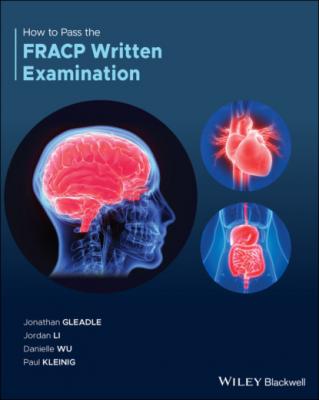How to Pass the FRACP Written Examination. Jonathan Gleadle
Читать онлайн.| Название | How to Pass the FRACP Written Examination |
|---|---|
| Автор произведения | Jonathan Gleadle |
| Жанр | Медицина |
| Серия | |
| Издательство | Медицина |
| Год выпуска | 0 |
| isbn | 9781119599548 |
In contrast to heart failure with reduced ejection fraction, there is limited clinical trial evidence guiding the treatment of HFpEF. At present, no therapy including ACE inhibitors, angiotensin receptor blockers, β‐blockers and aldosterone antagonists has demonstrated mortality benefit in patients with HFpEF.
Managing comorbidities including hypertension, obesity, OSA, rate control for AF, and diabetes, are the mainstay of HFpEF treatment strategies. Diuretics can be used to reduce congestion and improve symptoms. Low‐dose spironolactone is recommended to reduce hospital admission on the basis of the TOPCAT trial results. Sildenafil is an inhibitor of phosphodiesterase‐5 that increases cGMP levels by blocking catabolism. Increased availability of cGMP could provide benefits for both vascular and myocardial remodelling, including attenuating hypertrophy, fibrosis, and impaired cardiac relaxation. In the RELAX trial, sildenafil did not improve 6 min walk distance or quality of life. Ivabradine is a selective sinus node If sodium channel inhibitor that reduces HR without affecting contractility. It can increase peak VO2 and reduced exercise mitral early diastolic velocity/mitral annular velocity (E/e') ratio.
Harper A, Patel H, Lyon A.AR. Heart failure with preserved ejection fraction. Clinical Medicine.Clin Med (Lond). 2018;18(Suppl 2): s24–s29. https://pubmed.ncbi.nlm.nih.gov/29700089/
18. Answer: D
Hypertrophic cardiomyopathy (HOCM) is a common monogenic cardiovascular disorder with a prevalence of 1 in 500. It is diagnosed with echocardiogram and MRI which shows a hypertrophic left ventricule without dilatation and it is not associated with another cardiac, systemic, metabolic, or syndromic disease. HOCM is diverse in clinical, phenotypic expression, and natural history. It is often underdiagnosed.
HOCM is inherited in an autosomal dominant pattern. It is associated with mutations (nucleotide sequence variants) in 11 or more genes encoding proteins of thick and thin myofilament contractile components of the cardiac sarcomere (Z‐disk), with beta‐myosin heavy chain and myosin‐binding protein C genes most commonly involved.
HOCM is predominantly an obstructive disease, with 70% of patients having mechanical impedance to left ventricular outflow (gradients ≥30 mm Hg) at rest or with exertion. Left ventricular outflow obstruction is usually produced by mitral‐valve systolic anterior motion and septal contact due to flow drag, causing complications such as mitral regurgitation, diastolic dysfunction, atrial fibrillation, congestive heart failure, and ventricular tachyarrhythmias.
HOCM is associated with increased sudden cardiac death associated with ventricular tachyarrhythmias, disorganised myocardial architecture, interstitial collagen deposition, and replacement scarring after myocyte death as a consequence of coronary microvascular mediated flow dysfunction and ischemia. Patients with a diagnosis of HOCM are often disqualified from participating in intensive competitive sports due to high risks of sudden cardiac death.
The American College of Cardiology and the American Heart Association (ACC–AHA) have developed an algorithm for risk stratification in patients with HOCM who would benefit from primary prevention of sudden cardiac death with implantable cardioverter–defibrillators (ICDs). ICDs should be considered in young and middle‐aged patients whose clinical profiles include one or more major risk factors, include family history of HOCM‐related sudden death, unexplained syncope, multiple, repetitive non‐sustained VT, massive LVH (≥30 mm), left ventricle apical aneurysm, and extensive late gadolinium enhancement. If the level of risk remains uncertain, other clinical features such as left ventricular outflow obstruction, hypotensive response to exercise, can serve as mediating factors.
Management strategies for variable clinical manifestation of HOCM include ICDs to reduce the risk of sudden cardiac death, surgical myectomy (with alcohol septal ablation as a selective alternative) for permanent reversal of heart failure in patients with outflow obstruction, heart transplantation for patients with non‐obstructive end‐stage disease, and anticoagulant therapy to prevent embolic stroke caused by atrial fibrillation.
Maron B. Clinical Course and Management of Hypertrophic Cardiomyopathy. New England Journal of Medicine. 2018;379(7):655–668.
https://www.ncbi.nlm.nih.gov/pubmed/30110588
19. Answer: B
This patient has papilloedema with almost complete obliteration of the margins of the optic disc and several hypertensive haemorrhages. Changes in hypertensive retinopathy include: Focal arteriolar narrowing and arterial venous nicking, flame or blot haemorrhages, microaneurysm, hard exudates, cotton wool spots, and papilloedema.
The Keith‐Wagner grade is used to classify the severity of hypertensive retinopathy:
Grade 1: Isolated narrowing of the arterioles.
Grade 2: There is moderate to marked narrowing of retinal arterioles associated with a copper wire appearance or arteriovenous nicking.
Grade 3: Hypertensive retinal haemorrhage or exudates are present.
Grade 4: Papilloedema is present.
Modi P, Arsiwalla T. Hypertensive Retinopathy [Internet]. Statpearls.com. 2020 [cited 16 November 2020]. Available from:
https://www.statpearls.com/articlelibrary/viewarticle/35600/
20. Answer: C
All of the above patients have a Class I indication for an ICD implantation except in the patient who just had a myocardial infarction two weeks ago. There is no survival benefit of early ICD implantation in patients with ischaemic cardiomyopathy. Evaluation of patients for ICD implantation should wait at least 40 days post‐myocardial infarction and an ICD is then indicated in patients with left ventricular ejection fraction less than or equal to 35% and at least 90 days post revascularisation, with NYHA class II/III symptoms despite guideline directed medical therapy.
The current indications for ICD to prevent sudden cardiac death (SCD) are summarised in Table 1 in the following full text article based on the 2017 American Heart Association/American College of Cardiology/Heart Rhythm Society (AHA/ACC/HRS) guidelines for management of patients with ventricular arrhythmias and the 2015 European Society of Cardiology (ESC) guidelines for management of patients with ventricular arrhythmias.
Chieng D, Paul V, Denman R. Current Device Therapies for Sudden Cardiac Death Prevention – the ICD, Subcutaneous ICD and Wearable ICD. Heart, Lung and Circulation. 2019;28(1):65‐75.
https://www.heartlungcirc.org/article/S1443‐9506(18)31920‐6/fulltext
21. Answer: D
This patient has infrequent palpitations which happen around once every 6 months. Three‐ or seven‐day Holter monitoring may not capture arrythmias due to the infrequent events.
It is important to know the frequency of palpitations or syncopal events to decide what the best way
